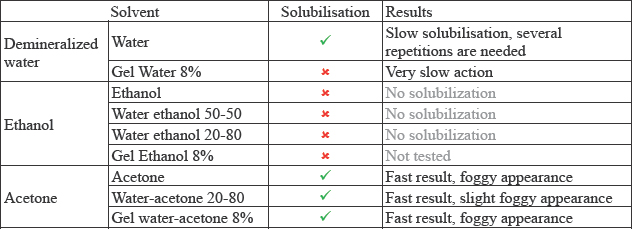
Topics in Photographic Preservation 2011, Volume 14, Article 3 (pp. 4-11)
Presented at the PMG session of the 2010 AIC Annual Meeting in Milwaukee, Wisconsin
The idea of this study started after an incident during the opening of an exhibition of big format silver gelatin prints in a museum in Paris. During the opening someone threw a liquid all over the photograph hanged into the wall without any protection.
The Atelier de Restauration et de Conservation de Photographies de la ville de Paris (ARCP) for its advice. The photograph was examined with raking light; where the liquid was projected it had a more matte aspect; the drops at the end of the draining were yellow with a viscous appearance. A solubility test was done under the hypothesis that the liquid was a drink given under the opening. The solubility tests were done with multiple solvents, in liquid and gel form. Finally, it was considered that the results were not as good to treat the entire image.
After the emergency confronted, it was decided to carry out a test that could bring up a solvent, a treatment and the time to perform the intervention. The test was divided in two parts. The first one was to search the ‘good’ solvent and technique for the cleaning of the beverages. A glass was used to avoid factors as dryness and penetration. The second part pursued to know the consequences of the beverage in the emulsion, to test the cleaning technique of the part one and to determine the time of intervention to have positive results. Several beverages were tested: over a silver-gelatin print in baryta paper.
The final results were acceptable, for the most part of the beverages the solvent and technique could remove the residues and not change the emulsion surface and it could be understand what happened in the interaction between the liquid and the gelatin.
The idea of this study started after an incident that happened during the opening of a photograph exhibition in a museum in Paris where a patron spilled some liquid all over the photograph. The damaged photograph was a large format gelatin silver print (111 x 88 cm) that had been printed in 1982on a baryta paper mounted on a sheet of aluminum and was exhibited without glazing.
The Atelier de Restauration et de Conservation de Photographies de la ville de Paris (ARCP) was called by the museum for advice; Marsha Sirven, the head of the Atelier’s conservation section and conservators Pilar Hernández and Lara Kreuzburg responded to the emergency. Upon visual examination of the photograph, a viscous, yellow residue was observed at the end of each drip and in some cases it looked already dry. Under raking light a change of the surface could be observed in the drips: where the liquid was projected the surface looked more matte.
Solubility tests were done on site with the hypothesis that the liquid was a beverage served at the opening. The Teas diagram was consulted but it did not include any beverages. The solubility tests were done with demineralized water, ethanol, acetone, ethyl acetate, methyl-ethyl-acetone and 1-1-1 trichloroethane, and a hydroxypropylcellulose gel (Klucel G). None of the solvents tested gave good results and the photograph was not treated.
The ARCP staff discussed the problematic and the emergency confronted, and decided to carry out a test that would help future intervention in similar situations. The tests were divided in two parts. The first one searched for an appropriate solvent and for a cleaning technique that would remove the beverages. To avoid other factors such as penetration, a glass sheet was used for this test. The second part tested the cleaning technique on a gelatin silver print, looked into the emulsion damages caused by the beverages; and determined the response time for this type of emergency.
The tested beverages included champagne, Heineken® beer, picon and manzana liqueurs, white wine, two different orange juices (Leader Price® and Tropicana®), Diet Coke® and Coke®.
A pipette Pasteur was used to create eight drops of each beverage (2ml), on a 15 x 20 cm glass sheet. The drops were left to dry to observe how much liquid evaporated (water, alcohol or other compounds), and look at their new characteristics. After an hour it was noticed that all the drops were consistently sticky and that their color remained the same.
The absorption method was the first to be tested using cotton swabs, blotter, filter paper and paper napkins. Blotting and pointing were done with all the materials, and rolling was done only with the cotton swabs.
Blotter paper was the most effective material to remove liquid or viscous residues
Solubility tests were done after removing most part of the beverage residues with blotting paper. The following materials were used:
Solvent tests
Solvents were applied by rolling a cotton swab.


Solubility tests conclusions
The water-acetone 20-80 mixture gave the best solubility results for all the beverages and it will be tested with beverage residues on a gelatin silver print. The water-acetone gel 8% will be used for persistent stains.
The second part of the tests was done with two silver-gelatin prints, using a 12x16” Ilford® Multigrade baryta paper (MGW1K) produced by the ARCP documentation section in 2005.
We tried to reproduce the conditions in the opening incident: the photograph was fixed vertically on a board and one millilitre of the beverage was spilled with a pipette Pasteur to create a drip on the surface of the photograph. Three drips were produced for each beverage. The time between the sample preparation and the cleaning test was between 5 minutes and 24 hours, depending in the drying time.
First, most of the residues were removed by absorbing the liquid with a blotter, trying not to touch the emulsion surface. Then, a cotton swab with the mix water-acetone 20-80 was rolled on the area to solubilize the residues.
After cleaning with the 20-80 water-acetone solution and the application of the Klucel G gel 8% with the same solvent, the effects of the beverages on the gelatin emulsion could be observed.
The water-acetone gel gave very good results both in the cleaning of the beverages residues and in the recovery of the emulsion appearance.
The next table describes the observation and is illustrated with the before and after image.
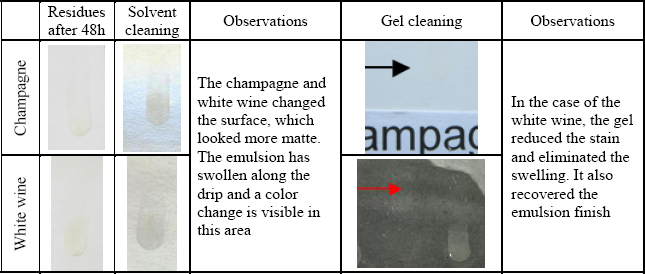

The tested beverages had different effects on the gelatin emulsion because their viscosity and composition which determined the way that they drip, their penetration in the emulsion and the time they dried. The test observations for each liquid are described below.
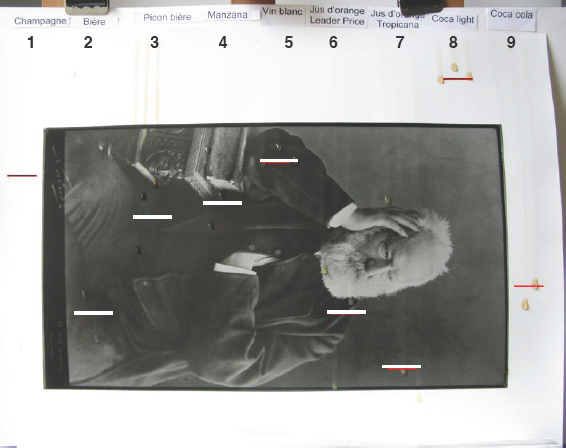
Three modifications in the surface were observed after the cleaning tests:
The stains were produced by the penetration of the beverage’s colorants into the emulsion, like with the Coke® and Diet Coke® where the stains could not be cleaned. The viscous beverages with a high amount of sugar could not easily penetrate into the gelatin, due to their molecular size. The picon beer had a similar color as the Cokes but did not leave a very visible stain and it was easy to clean. Transparent liquids, like the manzana, did not leave any stain.
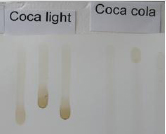
Stains caused by the Coke® and the Diet Coke®
Due to the beverages’ high water content (sometimes more than 80%), the photographic emulsion swelled in the exact area where the drop rests on, working as a gel and letting beverages’ compounds penetrate the gelatin. The deformation size depends on how much time the liquid remained in contact with the emulsion and on the beverage’s composition. We observed that the minimum time needed to produce this reaction was 30 minutes. Diet Coke® was the exception and did not generate any swelling, as it dried very fast. The drips that rested for more than two days caused a contraction in the emulsion, probably caused by the sugar compounds.

Swelling caused by the Picon beer

Shrinking of the drips after 48 hours
The changes in the emulsion finish can be explained by the acidity of the white wine and the champagne. Under the microscope the emulsion has more texture; when it is observed with the naked eye, the light scatters on these little particles and the surface seems to be covered by a veil or a whitish stain.
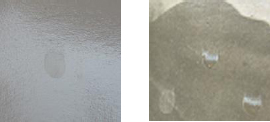
Left, champagne; right, white wine
After looking at the white wine and champagne residues and their effects on the emulsion, it was noted that they were similar to the ones on the damaged photograph. In order to better understand the effects of these beverages and trying to prove that one of these was thrown onto the photograph, another test was done.
Six drops of each beverage were placed horizontally on one of the tested photographs. The first tests were done just five minutes after preparing the sample and the rest were removed with a five minutes difference; being thirty minutes the longest time for the sixth and last drops.
The difference in the photograph position caused the stains to get darker; probably because the gravity caused the emulsion to absorb more liquid. In both cases, the matte effect could still be observed when the photograph was placed vertically. The first tests left a less visible stain and in the case of the white wine they were not noticeable. The differences between these two beverages were that the champagne dried slowly and left a darker stain since it remained humid for more time.
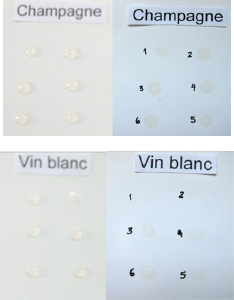
The champagne stains are more visible
The final cleaning technique can remove and minimize most beverage residues on the silver gelatin print. The treatment starts with absorbing most of the residue with a blotter paper followed by rolling a swab of water-acetone 20-80 on the remaining residues. Finally, a Klucel G 8% gel in 20-80 water-acetone can be applied to recover the emulsion appearance and lessen the stains.
After performing the tests, it is clear that the effects of colorized beverages (Diet Coke® and Coke®) on a photograph can be fatal. Also, the shorter the time we proceed with the treatment, less consequences remain on the photograph. Further tests should be done to understand the interaction between the gelatin emulsion and gels and to explore their use on the cleaning of photographs. Other tests could be done to determine the effects of beverages on digital prints.
Photographs exhibited without glazing are at higher risk of damage, especially during openings or any time beverages are permitted and offered in the exhibition areas. Curators, conservators and collections managers should share information on incidents to help make more informed decisions and keep their photograph collections in the best way.
Participation of Pilar Hernandez in this study was thanks to a Professional Development Grant of The Getty Foundation and the generous support of Anne Cartier-Bresson and the City of Paris.
Papers presented in Topics in Photographic Preservation, Volume Fourteen have not undergone a formal process of peer review.